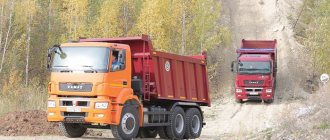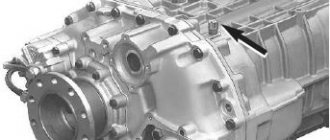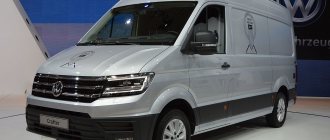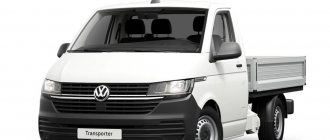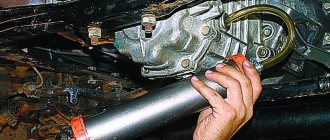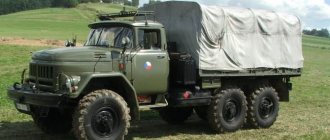Fuel tanks
What are truck fuel tanks? These are complex, high-tech components that ensure maximum reliability of the entire system. They have long ceased to be simple fuel storage facilities. Modern tanks consist of many components and parts and have a capacity of several hundred liters.
Freight transportation is a popular area of activity with great demand among various types of customers. It often happens that delivery involves traveling a huge distance in the shortest possible time. Stopping to refuel is wasted time, not to mention the associated risk in the form of possible theft or damage in the parking lot. A 400 or even 800 liter tank can completely eliminate this need.
For a long time, tanks of increased volume were manufactured independently. But those days are long gone. Truck manufacturers have found a way to increase dimensions. What is the reason? A larger tank carries a larger load. In addition to rigidity and corrosion, many more issues needed to be addressed. Modern analogues are not only larger, but also more reliable. The size of one of the most popular options is 800 liters, and this is far from the limit. Particularly important points include compliance with environmental standards and fire safety of the unit. The harmfulness of fumes decreases every year. Many manufacturers of trucks and tanks in particular focus on this.
Form
The cubic shape is considered the internationally accepted standard today.
Parameters such as length, width and height still remain floating. You can find the following forms: - cube; - cylinder; — D-shaped cube; - oval cylinder. One of the most recent companies to abandon their original tank design was Volvo. The cylindrical shape can be seen on its trucks until 2002.
Design
Any fuel tanks for modern trucks have a number of similar structural elements.
These are: - partitions with holes; — presence of a sump; — fuel sensor; — pressure reduction valve; — a set of filters. Fuel is poured through a special hose built into the neck. At its end there is a filter, most often a regular mesh one. Excess intake fuel is returned by the fuel system to the tank, forming a kind of circulation. The partitions play the role of stiffeners. They also prevent foaming and dampen vibrations during movement. Using a sump, you can drain and flush the system - small particles and water accumulate here. A special valve reduces the pressure when a large amount of vapor is formed. Well, the sensor displays the fill level.
Material
The production of walls and partitions is the specialty of each plant. The most common are iron and aluminum options. Each of them is good in its own way. Iron tanks are more resistant to physical damage. They have great rigidity. However, this is not the most important thing in durability. Corrosion can destroy any metal within the first years after installation. Aluminum models are more environmentally friendly and last longer. The wall thickness ranges from 2 to 3.5 mm. They often have several layers, pressed or welded together.
Calibration of fuel tanks of trucks (1l = 1cm).
As you know, the easiest way to find out how much fuel is in the tank is to measure it with an ordinary stick, which you simply lower into the neck, measure the value... Judging by the fuel indicator on the dashboard, the tank can be empty, half full or full. So this device can only tell whether there is enough fuel until the next gas station, but, as you know, the easiest way to find out how much fuel is in the tank is to measure it with an ordinary ruler, or a stick, which is simply lowered into the neck, measure the value and then, using a calibration table, determine the remaining fuel. In this article we will provide information on different auto manufacturers.
Calibration of fuel tanks of DAF vehicles:
| 400l | 430l | 500l | 560l | 600l | 620l | 690l | 750l | 850l | 870l | 995l | |
| 10cm | 70l | 70l | 70l | 100l | 120l | 100l | 120l | 120l | 140l | 140l | 140l |
| 20cm | 130l | 140l | 140l | 190l | 240l | 200l | 240l | 240l | 270l | 280l | 280l |
| 30cm | 200l | 210l | 210l | 290l | 350l | 300l | 350l | 360l | 410l | 420l | 430l |
| 40cm | 270l | 280l | 280l | 380l | 470l | 400l | 470l | 480l | 540l | 560l | 570l |
| 50cm | 330l | 340l | 350l | 480l | 590l | 500l | 590l | 600l | 680l | 700l | 710l |
| 60cm | 400l | 410l | 420l | 600l | 660l | 720l | 820l | 840l | 850l |
Renault Magnum & Premium fuel tank calibration table:
| Centimeters | Tank 555l. | Tank 410l. | Tank 275l. |
| (liter in cm) | (liter in cm) | (liter in cm) | |
| 1 | 8 | 7 | 4 |
| 2 | 16 | 14 | 8 |
| 3 | 25 | 21 | 12,5 |
| 4 | 33 | 28 | 16,5 |
| 5 | 42 | 35 | 21 |
| 6 | 51 | 42 | 25,5 |
| 7 | 60 | 49 | 30 |
| 8 | 69 | 56 | 34,5 |
| 9 | 78 | 63 | 39 |
| 10 | 88 | 70 | 44 |
| 11 | 97 | 77 | 48,5 |
| 12 | 107 | 84 | 53,5 |
| 13 | 117 | 91 | 58,5 |
| 14 | 127 | 98 | 63,5 |
| 15 | 137 | 105 | 68,5 |
| 16 | 147 | 112 | 73,5 |
| 17 | 157 | 119 | 78,5 |
| 18 | 167 | 126 | 83,5 |
| 19 | 177 | 134 | 88,5 |
| 20 | 187 | 140 | 93,5 |
| 21 | 197 | 147 | 98,5 |
| 22 | 207 | 154 | 103,5 |
| 23 | 217 | 161 | 108,5 |
| 24 | 227 | 168 | 113,5 |
| 25 | 237 | 175 | 118,5 |
| 26 | 247 | 182 | 123,5 |
| 27 | 257 | 189 | 128,5 |
| 28 | 267 | 196 | 133,5 |
| 29 | 277 | 203 | 138,5 |
| 30 | 287 | 210 | 143,5 |
| 31 | 297 | 217 | 148,5 |
| 32 | 307 | 224 | 153,5 |
| 33 | 317 | 231 | 158,5 |
| 34 | 327 | 238 | 163,5 |
| 35 | 337 | 245 | 168,5 |
| 36 | 347 | 252 | 173,5 |
| 37 | 357 | 259 | 175,5 |
| 38 | 367 | 266 | 183,5 |
| 39 | 377 | 273 | 188,5 |
| 40 | 387 | 280 | 193,5 |
| 41 | 397 | 287 | 198,5 |
| 42 | 407 | 294 | 203,5 |
| 43 | 417 | 301 | 208,5 |
| 44 | 427 | 308 | 213,5 |
| 45 | 437 | 315 | 218,5 |
| 46 | 447 | 322 | 223,5 |
| 47 | 457 | 329 | 228,5 |
| 48 | 467 | 336 | 233,5 |
| 49 | 477 | 343 | 236,5 |
| 50 | 485 | 350 | 243,5 |
| 51 | 493 | 357 | 246,5 |
| 52 | 501 | 364 | 250,5 |
| 53 | 509 | 371 | 254,5 |
| 54 | 518 | 378 | 259,5 |
| 55 | 526 | 385 | 263 |
| 56 | 534 | 392 | 267 |
| 57 | 542 | 399 | 271 |
| 58 | 550 | 406 | 275 |
VOLVO D-shaped fuel tanks:
Tank diameter 710
| Tank volume (l) | Tank length(mm) | Measurement height (mm) | |||||||||||||
| 33 | 50 | 100 | 150 | 200 | 250 | 300 | 350 | 400 | 450 | 500 | 550 | 600 | 650 | ||
| 170 | 430 | 4 | 7 | 18 | 30 | 43 | 56 | 70 | 84 | 98 | 111 | 125 | 138 | 150 | 160 |
| 210 | 530 | 5 | 9 | 22 | 37 | 53 | 69 | 86 | 103 | 121 | 138 | 154 | 170 | 185 | 199 |
| 330 | 830 | 8 | 14 | 35 | 58 | 83 | 109 | 136 | 163 | 190 | 217 | 243 | 268 | 292 | 313 |
| 410 | 1030 | 10 | 17 | 43 | 72 | 103 | 136 | 169 | 203 | 237 | 270 | 303 | 334 | 363 | 389 |
| 450 | 1130 | 11 | 19 | 47 | 79 | 113 | 149 | 186 | 223 | 260 | 297 | 332 | 367 | 399 | 428 |
| 480 | 1220 | 12 | 21 | 51 | 86 | 123 | 161 | 201 | 241 | 281 | 320 | 359 | 396 | 431 | 462 |
| 490 | 1230 | 12 | 21 | 52 | 86 | 124 | 162 | 202 | 243 | 283 | 323 | 362 | 399 | 434 | 466 |
| 530 | 1330 | 13 | 22 | 56 | 93 | 134 | 176 | 219 | 263 | 306 | 350 | 392 | 432 | 470 | 504 |
| 570 | 1430 | 14 | 24 | 60 | 100 | 144 | 189 | 235 | 282 | 329 | 376 | 421 | 465 | 506 | 542 |
| 610 | 1530 | 15 | 26 | 64 | 107 | 154 | 202 | 252 | 302 | 353 | 402 | 451 | 497 | 541 | 580 |
| 650 | 1630 | 16 | 28 | 69 | 115 | 164 | 216 | 269 | 322 | 376 | 429 | 481 | 530 | 577 | 618 |
| 690 | 1730 | 17 | 29 | 73 | 122 | 174 | 229 | 285 | 342 | 399 | 455 | 510 | 563 | 612 | 657 |
| 710 | 1800 | 18 | 30 | 76 | 127 | 181 | 238 | 297 | 356 | 415 | 474 | 531 | 586 | 637 | 683 |
| 730 | 1830 | 18 | 31 | 77 | 129 | 184 | 242 | 302 | 362 | 422 | 482 | 540 | 596 | 648 | 695 |
| 730 | 1850 | 19 | 31 | 78 | 130 | 186 | 245 | 305 | 366 | 427 | 487 | 546 | 602 | 655 | 702 |
| 750 | 1900 | 19 | 32 | 80 | 134 | 191 | 252 | 313 | 376 | 439 | 500 | 561 | 619 | 673 | 721 |
| 770 | 1950 | 20 | 33 | 82 | 137 | 197 | 258 | 322 | 386 | 450 | 514 | 576 | 635 | 691 | 741 |
| 810 | 2030 | 21 | 34 | 86 | 143 | 205 | 269 | 335 | 402 | 469 | 535 | 599 | 661 | 719 | 771 |
| 870 | 2196 | 22 | 37 | 93 | 155 | 221 | 291 | 362 | 435 | 507 | 579 | 648 | 715 | 778 | 834 |
Tank diameter 710
| Tank volume (l) | Tank length(mm) | Measurement height (mm) | ||||||||||
| 35 | 50 | 100 | 150 | 200 | 250 | 300 | 350 | 400 | 450 | 500 | ||
| 160 | 530 | 6 | 9 | 23 | 39 | 55 | 72 | 89 | 106 | 122 | 138 | 152 |
| 255 | 830 | 9 | 14 | 36 | 61 | 87 | 113 | 140 | 167 | 193 | 217 | 240 |
| 320 | 1030 | 11 | 18 | 45 | 76 | 108 | 141 | 174 | 207 | 240 | 270 | 299 |
| 380 | 1230 | 13 | 21 | 54 | 91 | 129 | 169 | 208 | 248 | 287 | 323 | 357 |
| 415 | 1330 | 14 | 23 | 59 | 98 | 140 | 182 | 226 | 268 | 310 | 350 | 386 |
| 445 | 1430 | 15 | 25 | 63 | 106 | 150 | 196 | 243 | 289 | 333 | 376 | 416 |
| 505 | 1630 | 17 | 28 | 72 | 121 | 172 | 224 | 277 | 329 | 380 | 429 | 474 |
| 540 | 1730 | 19 | 30 | 77 | 128 | 182 | 238 | 294 | 350 | 404 | 456 | 503 |
| 570 | 1850 | 20 | 32 | 82 | 137 | 195 | 254 | 314 | 374 | 432 | 488 | 538 |
| 600 | 1950 | 21 | 34 | 86 | 144 | 205 | 268 | 331 | 394 | 456 | 514 | 568 |
| 630 | 2030 | 22 | 35 | 90 | 150 | 214 | 279 | 345 | 410 | 474 | 535 | 591 |
Technical support
Naimushin Andrey Alexandrovich +7
Office
+7 (391) 2-811-810 8 This email address is being protected from spambots. You need JavaScript enabled to view it.
Renault Magnum technical specifications.
Speaking about the technical characteristics of Magnum family trucks, it should be noted that the flatbed truck, truck tractor and chassis had a 4x2, 6x2 and 6x4 wheel arrangement, a total weight of 18-26 tons and 15 wheelbase modifications (3920-6820 mm). The truck had an Optidriver+ 12-speed automatic transmission. The machine is very easy to use. Thanks to the smooth gear shifting, the ride becomes very comfortable.
In addition, you can take advantage of the optional Optifuel package. The Optifuel Infomax system will satisfy the most demanding drivers who pay increased attention to fuel consumption. The Optifuel Training system allows you to learn how to drive more economically and also shows the difference in fuel consumption for different driving styles.
The front suspension is on parabolic springs or air springs, the rear suspension is pneumatic with ECS electronic control. All-wheel disc brakes are controlled by Full EBS with ABS and ESP stability control.
In addition, there is such an important thing as a tire inflation sensor, which shows the tire pressure, thereby warning of the possibility of an emergency.
Fuel tank volume – 1225 or 1455 l.
Renault Magnum fuel consumption per 100 km.
Renault Magnum is a full-size long-haul truck-train. It is a truck tractor with a semi-trailer. There is also a modification in the form of a flatbed truck with a trailer. The first generation car was released in 1990. The car received a wide variety of modifications, including different wheel formulas - 4x2, 6x2 and 6x4. The total carrying capacity of the vehicle ranges from 18 to 26 tons, and the volume of the wheelbase ranges from 3920-6820 mm, depending on the modification. In 1991, just a year after the start of sales, the Renault Magnum received the Truck of the Year award.
The latest generation of Renault Magnum is the fourth. The car was produced from 2005 to 2013.
Among the main features of the car, we note a large windshield and massive rear-view mirrors. The outside door handle is located under the door. Let’s also pay attention to the non-standard arrangement of the footrests – this has its pros and cons.
Third life behind the wheel. Opinion of the driver of a Renault T tractor with a Turkish Koluman semi-trailer
“A third life behind the wheel, three centuries without sleep, floods our hearts with gray rain,” sings Yuri Shevchuk. And we haven’t discussed the topic of heavy-duty transport for a long time, so we turned to the Zeynela company, which found us a driver from a Brest company to give us an opinion on a Renault T tractor with a Turkish Koluman semi-trailer.
“We are driven around the world by wind and rock. Golden foliage, blazing with fire, along with fidelity, rushes to the end. Only night black soil. Chernozem. There's a star in the sky."
This tractor was driven all over the world, we couldn’t even catch it for a long time, it was the first in Belarus to which a Turkish Koluman trailer was attached. We recently wrote that the Koluman company has come to our market; our official distributor Zeynela is selling equipment. It's time to get the first reviews, so driver Alexander will talk about the Renault T tractor and the Turkish Koluman trailer:
“Our company has 15 trucks, mostly all new or some used. Models Renault T and DAF XF 105. My tractor is a 2022 model, we took it new, now it has a mileage of 140 thousand kilometers. He travels 7-8 thousand kilometers a month. Load capacity - 20 tons, total weight - 38 tons, Euro-6. The fact that it is new is good - nothing breaks. You just drive - that's all.
The power of the 13-liter engine is 440 horsepower, it is diesel with urea. This is not a new engine, it was removed from the Renault Magnum. Consumption when empty is 25 liters per 100 kilometers on the highway. If you load 20 tons, you will get 32-33 liters per “hundred”. Not to say that it is particularly economical. The D AF 105, which the company has, has 8 cylinders and 460 horsepower - it is more powerful and at the same time more economical: 27 liters per 100 kilometers. That's it, there were no breakdowns. Only the consumables were changed. Renault T is still under warranty and on lease.
But the Renault T has a large cabin - this is a plus. As for the equipment and electronics, it is even “over-equipped”. There is cruise control, air conditioning, a refrigerator, track and intersection sensors. The lane keeping system emits a signal when crossing a lane marking, but does not control the steering wheel. There is a warning system for the risk of collision. There are parking sensors for reverse. In general, it seems to be commercial equipment, but everything is there for convenience.
The gearbox is a 12-speed robot with one clutch, controlled by a switch on the steering column. I don’t like the way it works: it “thinks” for a long time when shifting, and literally an hour and a half ago I noticed that at slow speeds it can change gears roughly. It would be better if there were simple “mechanics” here, it would be easier.
In principle, it’s comfortable to drive, everything is accessible, the seating position is comfortable. But I'm not happy with the box. I'm used to driving a manual car. It’s good that you don’t have to pull the slide when you’re stuck in a traffic jam—that’s the only plus.
But the seat is comfortable, there are many adjustments to suit any driver. The steering wheel is also adjustable. Solid electric drives, which is convenient; the steering wheel is only mechanically adjustable. Noise insulation and suspension - no complaints. It goes smoothly, but you can feel the asphalt transitions well, the suspension doesn’t like hard joints, and everything is so soft. The electronic limiter is activated at a speed of 86 kilometers per hour. It pulls uphill, not to say confidently - 440 horsepower is not enough, you need at least 480. But it’s comfortable and new - you don’t get tired, nothing breaks.
We have purchased only one trailer so far to try what it is all about - a Turkish semi-trailer. We saw it at the BAMAP exhibition and liked the look, so we decided to try something new. As a result, we are thinking of purchasing more trailers like this. We've been driving with it for six months now - nothing has broken. The tires are good - all-season Bridgestone. It holds the load well, you can safely load it.
Tuning Renault Magnum.
Since the Renault Magnum is a commercial vehicle, a cargo vehicle, its appearance is not particularly changed. You can, however, install an additional body kit and apply airbrushing to the body. As for the technical part, improvements are very rare. However, if you wish, you can, of course, do chip tuning to increase power and torque.
True fans of truck tuning can enjoy racing Magnums. — since 2007, the main participant in Truck Racing. Racing Magnums are powered by DXi 13 Racing engines with 1160 hp, which were specially developed for these races. It is a very reliable and highly efficient 12.8L engine. In 2010 it was named best in class. With this engine, the Magnum accelerates from 60 to 160 km/h in just seven seconds.
In addition, designers carefully work on the appearance of the trucks. The design is so bold and modern that no one will remain indifferent.
Interior of Renault Magnum.
A truly real sensation in the interior of the truck was the absolutely smooth and flat floor in the cabin. Everything in it was created for greater driver convenience, in some ways even at home. In the first generations, the cabin height was 187 cm. Useful space in the fourth generation Magnum increased to 8 cubic meters. m. The dimensions of the cabin have increased significantly: height – 207 cm, depth – 201 cm, width – 207 cm.
The salon has become completely transformable using the latest Multi Space concept. An original layout, an enlarged bed equipped with a mattress, the ability to rotate the passenger seat 90 or 180 degrees, compartments for storing personal belongings with a volume of 1090 liters - all this is a modern Renault Magnum.
The instrument panel has a modern design and a very stylish look. Its main feature is its information content.
The updates also affected audio equipment. Depending on the cabin modification, CD + Bluetooth, USB, MP3 are available.
The windows are touch controlled, allowing you to focus all your attention on the road.
The French automaker offers the truck with two types of cabs: Solo (single) and Duo (double). There are also three modifications to choose from: Classic (minimum), Privilège (standard) and Excellence (maximum).
Peculiarities
Renault Magnum has quite a lot of advantages. One of the main ones is a flat floor in the cabin. And in general, the entire cabin is made to a very high level, which guarantees maximum comfort for both the driver and passengers.
Many owners speak of the Magnum as a very reliable, powerful and beautiful truck. By the way, about beauty. If you compare it with other trucks, the French manufacturer managed to create a truly solid and impressive appearance. The entire concept of the cabin is perfectly emphasized by chrome inserts on the visor, dimensional indicators, LEDs and a radiator grille painted in two tones.
It is worth noting that designers from Milan recognized this model as the most beautiful among all cars of this class. Moreover, the Renault Magnum was even able to outperform such fairly strong competitors as the Mercedes Actros and Volvo FH16.
But besides its advantages, the model also has some disadvantages, including:
The first and most famous drawback of the model is considered to be a very strange setup of the cabin suspension. Many owners note that the cabin moves too freely relative to the structure. Although there are reliable attachment points, the problem remains in the latest models. It feels like the chassis goes into a turn first, and only then the cabin itself. In addition, the cabin was too soft, which is why everything in the cabin shakes on uneven surfaces, when on other similar models everything is different. This suspension has accompanied this model since the first years of production, but compared to the first generation, the situation in new trucks has improved, but only slightly.
Since the entire design has an abundance of sharp lines, and the overall car is boxy, it has poor aerodynamics. But this does not affect speed performance, but the cleanliness of the handrails, which accumulate quite a lot of dirt when driving in any weather conditions. In principle, this problem could be partly solved by deflectors, as is done on most other trucks, but the French tractor does not have them from the factory.
Due to the transfer of the steps behind the front wheels, getting into the cabin has become difficult and uncomfortable, but drivers still get used to it over time.
Three generations of Renault Magnum had poor heating systems. If in Europe the stove coped with its task perfectly, then in Russian conditions its effectiveness was not enough. In winter, drivers used an autonomous heating system instead of a standard stove. The fourth generation received a more efficient heater.
Although the cabin is quite comfortable, the only inconvenience for many drivers is often the driver’s seat. On long flights, drivers often experience back pain due to the shape of the seat itself. The problem is solved by simply replacing it with a seat from another truck.
Since high-quality diesel fuel is quite rare at gas stations in Russia, the fuel filter on the Renault Magnum suffers greatly because of this. In this regard, it has to be changed very often. But in addition to the filter, various malfunctions can also appear in individual pumps, all for the same reason.
The chassis, despite its reliability, also has weak links. They were weak springs used by the brake pads, and the rear stabilizer. Springs are not sold separately, but are only available together with pads. The brake pads themselves can last quite a long time, but they wear out unevenly. This is due to the fact that the brake calipers have a factory defect, on all models.



